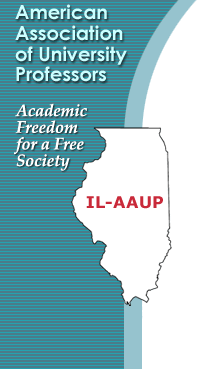Home | IL Academe | About IL AAUP | Conference Corner | Calendar | Services | Committees | Contact Us | Grants | Reports | Links
 |
 |
 |
On Strengthening Shared Governance Column by Ken Andersen For varied reasons, the strength of shared academic governance has weakened on many campuses. Reasons include neglect on the part of the faculty; increased emphasis on stakeholders other than the faculty; and a hostile or dismissive attitude on the part of administrators, trustees, and external groups including the press. What follows is a series of suggestions of possible faculty responses (individual or collective) as appropriate for particular situations. Each could be amplified in greater detail. I. Assert the prerogatives of governance and of individual faculty members. A. Insist on adherence to bylaws, statutes, handbooks, i.e., the social contract. B. Recognize the need for timely decisions balanced by the need to develop a solid rationale for decisions. (Seek consensus, unanimity may not be possible!) C. Build relationships as a basis for communication with the press, trustees, community leaders and legislators. II. Strengthen interaction with administrators and other governance groups and build mutual relationships of trust in advance of times of tension and stress. A. Create advisory committees for key administrators that have no direct faculty contact. B. Use administrative liaisons in ex offico roles on relevant committees. C. Have faculty move in and out of administrate roles and offices: special projects, part-time administrative roles, internships . D. When they do not exist, create settings in which administrators report to faculty on agendas and issues—prospective and retrospective—with dialogue encouraged. E. Give public support and praise to the administration as merited. F. Establish cooperative working relationships with student and staff governance groups. G. Establish an appropriate degree of personal contact with trustees or regents.
III. Concentrate energies upon key issues where faculty input is essential to an optimum solution. A. Put to good use the expertise resident among faculty. B. Insist the information required to make an informed decision and to monitor relevant activities is provided. C. Use ad hoc committees and subcommittees as needed. Do not undercut existing governance structures and insist administratively appointed committees do not usurp the role of regularly constituted governance committees. D. As needed, clarify and reinforce the role and function of faculty participation in institutional governance.
IV, Ensure appropriate recognition and support is given to shared governance activity and those participating in it.. A. Obtain support such as released time, secretarial support, and budgets for governance activity. B. Ensure the “reward system” gives proper recognition to meaningful governance activity. C. Do not countenance inactive chairs, inept office holders, those accepting but not fulfilling their responsibilities. D. Provide workshops or mentoring to those new to governance activity. E. Provide governance activities demanding limited time commitments for young faculty. F. Continuously review and modify structures: drop unneeded committees, create new ones as needed or develop new committee charges. G. Change committee memberships and chairs to develop broader expertise among the faculty. H. Recognize service with a personal thank you, commendation or other recognition individually and collectively. Those not active in shared governance work need to support that activity and help those active in it.
|
|